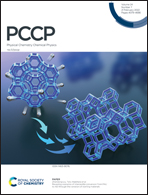K+ extraction induced phase evolution of KFeO2†
Abstract
Orthorhombic KFeO2 has a unique structure where K+ cations can migrate inside the Fe–O skeleton, thus making it a promising material for heterogeneous catalysis and electrochemical energy storage devices. However, KFeO2 is sensitive to conditions such as moisture and carbon dioxide, which would trigger severe phase evolution and consequently deteriorate the performance. In this work, we investigated the phase evolution using freshly prepared KFeO2 and KFeO2 after exposure to ambient air and after immersion in water, respectively. We found that the phase evolution of KFeO2 was composed of K-redistribution and phase transition, both of which originated from K+ extraction. We observed that K+ cations were extracted after exposing KFeO2 to ambient air, resulting in the formation of K2CO3·1.5 H2O outside KFeO2 and lattice expansion inside KFeO2. We also observed that water molecules were crucial to K+ extraction when calculating the function between potassium and the adjacent oxygen atoms via ab initio molecular dynamics simulations. Moreover, we successfully reinserted K+ cations into lattice expanded KFeO2 by high-temperature calcination at 900 °C; such a reversible extraction–insertion process would have great potential for application in catalyst reactivation and rechargeable high-temperature batteries.



 Please wait while we load your content...
Please wait while we load your content...